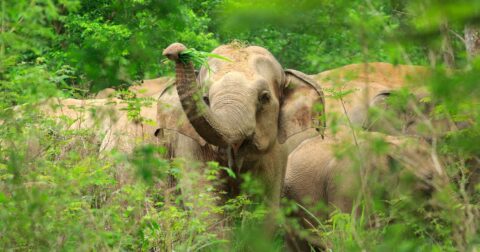Feature
How Much Meat Can You Eat and Still Be ‘Climate-Friendly?’
Research•9 min read
Explainer
Magpies hold funerals and elephants travel to pay their respects.


Words by Jennifer Sizeland
You might think of grief as an exceptionally human emotion but scientists have discovered many examples of animals mourning much like people do. This evolving field of research documents how animals exhibit a complex range of feelings towards death.
One noted example: famed chimpanzee researcher and advocate Jane Goodall watched as Flint, a young male chimp, died just four weeks after his mother Flo passed away; he was unable to eat or spend time with others.
“We humans don’t own love or grief — these emotions are widespread in other animals,” said renowned biological anthropologist and author on animal grief, Barbara J. King, to the BBC in 2018.
As early as the 1950s, scientists were documenting evidence of the grieving process in animals. Animal grief falls under the umbrella of ‘epimeletic behavior,’ a term used by the late pioneering behavior geneticist John Paul Scott in his 1958 research to describe a broader category of behavior: the way animals care for others. Primatologist Harry Harlow separated rhesus monkeys from their mothers for instance, finding that they behaved in a lethargic and unresponsive way until they were reunited. The same type of experiment was then performed on adult monkeys and their companions, provoking similar responses.
Today, this growing body of research suggests that animals may grieve as deeply as humans when they lose a family member. What scientists observe is a window into the way they relate to each other on an emotional level. “I don’t believe all species have to be ‘clever’ to experience grief, they need to be capable of processing this emotion, and recognizing that a valued member of their social unit has gone,” says animal behavior scientist Paul Rose, who lectures at the University of Exeter in the U.K.
Many smaller creatures grieve too, according to the research. Biologist and behavioral ecologist Marc Bekoff witnessed a ‘wake’ amongst magpies after one bird was hit by a car, for instance. They pecked at the body and laid pine needles and twigs next to it once death was determined, even standing around the body for a time.
Bekoff also witnessed a red fox burying her mate with dirt and branches when he was killed by a cougar. After writing about his observations in an article for Yes! magazine, Bekoff said he “got emails from people all over the world who had seen similar behavior in various birds and mammals.”
While we can’t definitively say how animals feel and define it in the same terms as the ways that humans experience things, the research offers incredible insights into the complex emotional lives of these five mammals:
A 2006 study of baboons in Botswana measured an increase in the animals’ stress hormones following a death in their troop. In contrast, when the animals made friendly contact and strengthened social bonds with other baboons in the network, the researchers found the animals had reduced stress hormone levels.
Baboons are also one of many primates who carry and continue to care for their infants after they have died. A 2020 study of chacma baboons in Namibia attributed this death response to a combination of the ‘grief-management hypothesis’ (where carrying the infant helps them deal with their emotions) and the ‘social-bonds hypothesis,’ (carrying due to the intense bonds created between the two). A 2022 study found chimpanzees in the Budongo Forest in Uganda exhibited a similar response to the death of their infants as well.
According to James R. Anderson, a comparative psychologist who works at Kyoto University in Japan, it’s “unlikely” that these animals don’t know that their infant is dead. “Some researchers have suggested that in many cases this behavior might be a mechanism that facilitates the mother’s coping with the loss of her offspring,” he says. Just how long the mother carries the baby depends on many factors, including environmental conditions, according to Anderson.
This past summer, a tour group in Spain’s Bay of Biscay observed a Curvier’s beaked whale potentially in mourning, one of the most recent examples of animals exhibiting possible grieving behavior. There, a mother was observed pushing her dead calf to the surface of the water, an action known as ‘display carrying.’ Researchers have seen this kind of behavior in other cetaceans but not beaked whales, who are generally elusive and rarely seen. Her emaciated condition meant that pushing him about came at great physical cost to her, as she was not feeding herself for the two days she was observed carrying her calf.
Various types of dolphins have also been seen grieving the loss of a member of their pod. In December 2012, off the coast of Hurghada in the Red Sea, researchers observed an adult Indo-Pacific bottlenose dolphin pushing the decaying body of a smaller dolphin. When biologists attached a rope to the carcass and dragged it to shore for burial, the adult dolphin continued to follow, touching the carcass until it reached shallow waters. The dolphin even remained there after the body had left the water. Researchers later confirmed the deceased dolphin was a juvenile and possibly its baby. Risso’s dolphins, spinner dolphins and short-finned pilot whales (a type of dolphin) have all exhibited similar mourning behaviors.
Scientists have documented many elephants in mourning. Wildlife documentary crews filmed moments of grieving on multiple occasions, including elephants carrying around the tusks of deceased members of their herd.
Elephants will even come to see the remains of those in other herds that they do not know. An elephant called Eleanor who died on October 11, 2003, in Kenya was visited, prodded and sniffed after death by five other groups of elephants, some of whom weren’t related or known to her. Researchers who watched it concluded this was a “generalized response” to death, greater than blood or mated bonds.
The neighbor of the African elephant, the giraffe, was observed by zoologists in Zambia in 2012, licking and nudging a dead calf while standing vigil by it, the third time on record. Both these animals have long gestation periods so the amount of time they spend growing their offspring is a huge investment and physical undertaking, much like humans.
African elephants are pregnant for 22 months, which is longer than any living mammal, while giraffes gestate for approximately 15 months. Scientist Paul Rose agrees that long periods of gestation may be connected to how long a parent grieves. “Species where attachment is vital for the development of young, are more likely to have a sense of loss,” he says.
Not every researcher is convinced that animals grieve in the way that humans do. James Anderson, for instance, takes the position that “grief and mourning in response to bereavement require knowledge about the meaning of death that I suspect most animals do not have.”
The key is to look at the different reactions to death from the same species to understand more, argues Paul Rose. “Given the number of species that will display signs of distress when members of their family or immediate social group are removed from them, concepts of grief are probably more widespread than we imagine,” he says.
Finding definitive proof will always be a challenge, in part due to how difficult it is to test a hypothesis about the inner lives of animals in valid and objective ways, he says. For him, species-specific biologists — the next generation of Jane Goodall’s pioneering work — may be key to truly understanding grief across species. These particular scientists use animal welfare methodologies that measure what are essentially repeated instances of certain types of body language to assess their moods or emotional responses.
Undoubtedly, animals have senses that we don’t quite understand, which adds to the questions about their reactions to death. They can smell cancer and other diseases, communicate over long distances, see things we can’t see, hear things we can’t hear and migrate across long distances using only their senses.
We haven’t really scratched the surface of what animals can do, and our ignorance almost certainly outweighs our knowledge. What we can be sure of, however, is that animals have social relationships, and that these bonds affect them. It’s something to keep in mind when it comes to the activities of humans that cause death to animals — there may well be a mate or family member who is left grieving them.